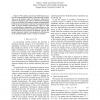746 search results - page 50 / 150 » Near-Optimal Radio Use for Wireless Network Synchronization |
121
click to vote
WIOPT
2010
IEEE
14 years 10 months ago
2010
IEEE
—Cognitive radio networks provide the capability to share the wireless channel with licensed (primary) users in an opportunistic manner. Primary users have a license to operate i...
106
Voted
WCNC
2008
IEEE
15 years 6 months ago
2008
IEEE
Abstract— We consider a scenario in which frequency agile radios opportunistically share a fixed spectrum resource with a set of primary nodes. We develop a collaborative scheme...
OPODIS
2004
15 years 1 months ago
2004
A sensor is a battery-operated small computer with an antenna and a sensing board that can sense magnetism, sound, heat, etc. Sensors in a network can use their antennas to communi...
118
click to vote
INFOCOM
2010
IEEE
14 years 10 months ago
2010
IEEE
—Wireless sensor network (WSN) applications require redundant sensors to guarantee fault tolerance. However, the same degree of redundancy is not necessary for multi-hop communic...
IWCMC
2006
ACM
15 years 5 months ago
2006
ACM
This paper introduces a novel symbolic positioning system based on wireless access points and Support Vector Machines. The system works both indoors and outdoors and is cost-effec...

